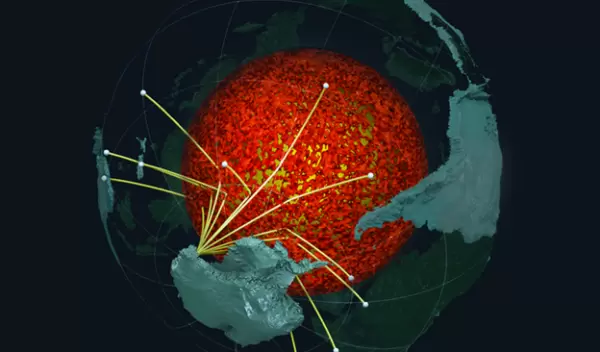
Beneath the Earth, ancient ocean floor likely surrounds the core
Through global-scale seismic imaging of Earth’s interior, U.S. National Science Foundation-supported research led by University of Alabama scientists has revealed a layer between the core and the mantle that is likely a dense, yet thin, sunken ocean floor, according to results published in Science Advances.
Seen only in isolated patches previously, the latest data suggest this layer of ancient ocean floor may cover the core-mantle boundary, or CMB. Subducted underground long ago as the Earth’s plates shifted, this ultra-low velocity zone, or ULVZ, is denser than the rest of the deep mantle, slowing seismic waves reverberating beneath the surface.
"Seismic investigations such as ours provide the highest-resolution imaging of the interior structure of our planet, and we are finding that this structure is vastly more complicated than once thought," said geologist Samantha Hansen, lead author of the study. "Our research provides important connections between shallow and deep Earth structure and the overall processes driving our planet."
These subtle signals were used to map a variable layer of material across the study region that is pencil thin, measuring in the tens of kilometers, compared to the thickness of the Earth’s dominant layers. The properties of the anomalous CMB coating include strong wave speed reductions, leading to the name ultra-low velocity zone.
ULVZs can be explained by former oceanic seafloors that sunk to the CMB. Oceanic material is carried into the interior of the planet, where two tectonic plates meet and one dives beneath the other, known as subduction zones. Accumulations of subducted oceanic material collect along the CMB and are pushed by the slowly flowing rock in the mantle over geologic time. The distribution and variability of such material explains the range of observed ULVZ properties.
The ULVZs can be thought of as mountains along the CMB, with heights ranging from less than about 3 miles to more than 25 miles.
"Analyzing thousands of seismic recordings from Antarctica, our high-definition imaging method found thin anomalous zones of material at the CMB everywhere we probed," said Edward Garnero, a study co-author. "The material’s thickness varies from a few kilometers to tens of kilometers. This suggests we are seeing mountains on the core, in some places up to five times taller than Mount Everest."
These underground "mountains" may play an important role in how heat escapes from the core, the portion of the planet that powers the magnetic field. Material from the ancient ocean floors can also become entrained in mantle plumes, or hot spots, that travel back to the surface through volcanic eruptions.
"This study is unique because it images widespread, variable ULVZs along the core-mantle boundary beneath a largely unsampled portion of the Southern Hemisphere," said Michael Jackson of NSF’s Office of Polar Programs. "The research also highlights the importance of NSF’s investment in high-quality seismic observations in Antarctica for resolving global Earth structures."
